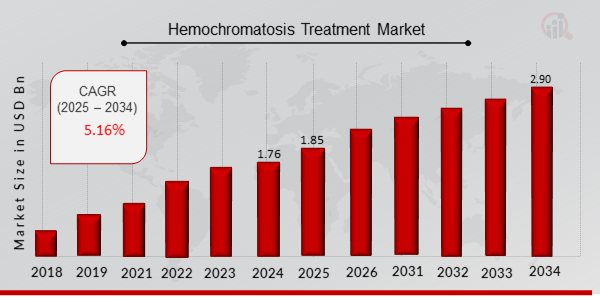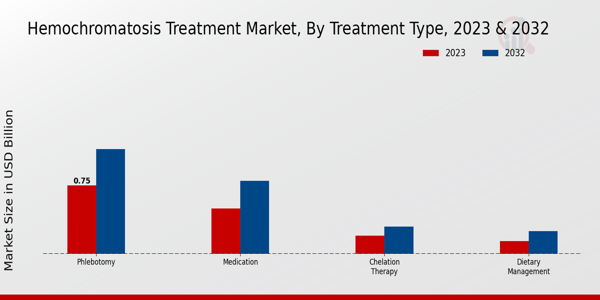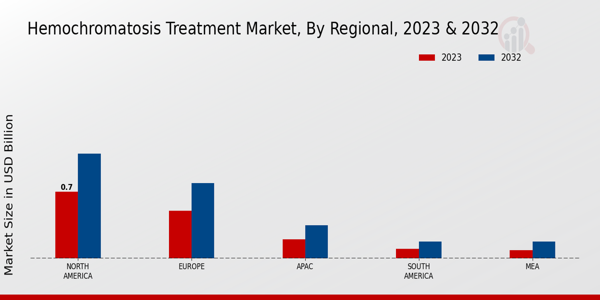Hemochromatosis Treatment Market Overview
As per MRFR analysis, the Hemochromatosis Treatment Market Size was estimated at 1.76 (USD Billion) in 2024. The Hemochromatosis Treatment Market Industry is expected to grow from 1.85 (USD Billion) in 2025 to 2.90 (USD Billion) till 2034, at a CAGR (growth rate) is expected to be around 5.16% during the forecast period (2025 - 2034).
Key Hemochromatosis Treatment Market Trends Highlighted
The Hemochromatosis Treatment Market is experiencing notable growth driven by an increase in the prevalence of iron overload disorders and rising awareness about hereditary hemochromatosis. The rising number of diagnosed cases, coupled with advancements in genetic testing and early diagnosis, is influencing the demand for effective treatment options. Additionally, government initiatives aimed at promoting research in rare diseases are boosting the market. Healthcare professionals are focusing on personalized medicine, which is likely to enhance treatment efficacy for patients suffering from this condition. Opportunities for growth in this market are expanding as healthcare systems around the world recognize the need for better management of iron overload.The development of innovative therapies, such as novel chelation agents and agents targeting specific iron metabolism pathways, presents an opportunity for companies to diversify their product portfolios. Moreover, the collaboration between pharmaceuticals and biotechnology firms is leading to the introduction of new treatments that will cater to different patient needs, further enriching the therapeutic options available. Recent trends indicate a shift toward the use of combination therapies and holistic approaches in treating hemochromatosis. This consists of incorporating lifestyle modification alongside medical management. Furthermore, the increasing use of telemedicine and remote monitoring tools signals a trend toward more accessible treatment options for patients.As patients demand more tailored care, the market is seeing a rise in digital health solutions that facilitate better communication between patients and healthcare providers. Overall, the focus on early intervention and patient-centered care continues to shape the landscape of the hemochromatosis treatment market.

Source: Primary Research, Secondary Research, MRFR Database and Analyst Review
Hemochromatosis Treatment Market Drivers
Increasing Prevalence of Hemochromatosis Cases
The rising incidence of hemochromatosis globally is a significant driver for the Hemochromatosis Treatment Market Industry. Hemochromatosis, a condition characterized by excessive iron accumulation in the body, is often undiagnosed or misdiagnosed, leading to a growing patient pool requiring treatment. Population growth, lifestyle changes, and increasing awareness of genetic disorders are contributing to the escalating number of diagnosed cases.With the market expected to see substantial growth, healthcare providers are focusing on improving diagnostic techniques and treatment options. As more individuals are diagnosed, the demand for effective treatment modalities increases, thereby projecting a favorable market trajectory. Healthcare systems are also recognizing the need for early diagnosis and intervention, further amplifying the importance of tailored treatment strategies to manage patients effectively.Coupled with advancements in medical research and the introduction of new medications and therapeutic approaches, this rising prevalence sets the stage for notable market expansion, providing a robust foundation for investment and innovation within the Hemochromatosis Treatment Market Industry.
Advancements in Treatment Modalities
The continuous development of innovative treatment options is another prominent factor fueling the growth of the Hemochromatosis Treatment Market Industry. Recent breakthroughs in therapeutic drugs, chelation therapies, and phlebotomy techniques are transforming how hemochromatosis is managed. These advancements not only enhance patient outcomes but also provide healthcare practitioners with more effective tools to address this complex condition.The evolution of treatment modalities encourages clinical trials and research investments, fostering a competitive market environment that drives further innovation. Additionally, the introduction of personalized medicine and targeted therapies is gaining traction, offering tailored approaches to individual patient needs. Such advancements are expected to result in a broader array of treatment options catering to a diverse patient demographic, ultimately propelling market growth.
Growing Awareness and Education Initiatives
The increasing awareness and education regarding hemochromatosis plays a crucial role in the expansion of the Hemochromatosis Treatment Market Industry. Efforts made by healthcare organizations and advocacy groups to educate patients and healthcare professionals about the condition are essential for early diagnosis and subsequent treatment. Educational campaigns focus on the symptoms and risk factors associated with hemochromatosis, driving more individuals to seek medical advice and, consequently, to receive treatment sooner.Furthermore, health professionals are being trained to recognize and manage hemochromatosis effectively, leading to improved patient care standards. This wealth of information not only enhances patient knowledge but also encourages proactive health management, positively influencing the growth of the treatment market.
Hemochromatosis Treatment Market Segment Insights:
Hemochromatosis Treatment Market Treatment Type Insights
The Hemochromatosis Treatment Market revenue is steadily progressing, with the Treatment Type segment playing a crucial role in its growth. In 2023, this market reached a valuation of 1.59 billion USD, reflecting increasing awareness and demand for effective treatment options. The market's segmentation reveals that Phlebotomy is the most significant treatment method, valued at 0.75 billion USD in 2023, anticipated to rise to 1.15 billion USD by 2032. This dominant position underscores Phlebotomy's critical importance in managing iron overload in patients, making it a primary choice for many caregivers.Medication, valued at 0.5 billion USD in 2023, is also gaining traction, predicted to reach 0.8 billion USD by 2032, which emphasizes the growing reliance on pharmacological interventions as complementary options to traditional methods like Phlebotomy. Chelation Therapy, though valued at 0.2 billion USD in 2023 and expected to increase to 0.3 billion USD, represents a significant but smaller segment, catering to patients who may not tolerate Phlebotomy well or who require additional treatment approaches. Dietary Management is valued at 0.14 billion USD in 2023, with projections of reaching 0.25 billion USD, highlighting its essential role in long-term management and prevention strategies alongside clinical treatments.The cumulative performance of these treatment types illustrates the market's dynamics, where Phlebotomy holds the majority share due to its effectiveness and direct impact on iron reduction. Overall, the therapeutic landscape in the Hemochromatosis Treatment Market is evolving, demonstrating that a combination of these treatment options will likely be key to offering personalized care for patients while driving market growth. Trends indicate that continued education on hemoglobin disorders, advancements in medical technology, and an increase in diagnostic testing contribute positively to the overall market growth, expanding opportunities for all treatment types while addressing the challenges associated with patient management and adherence.

Source: Primary Research, Secondary Research, MRFR Database and Analyst Review
Hemochromatosis Treatment Market Distribution Channel Insights
The Distribution Channel segment of the Hemochromatosis Treatment Market plays a crucial role in delivering therapies to patients effectively. In 2023, the market was valued at 1.59 billion USD, reflecting its importance in healthcare. Hospitals serve as a primary hub for treatment, offering comprehensive care for patients with hemochromatosis. Pharmacies and Online Pharmacies provide essential access to medications, catering to a growing demand for convenience and immediate availability, which significantly influences market dynamics. Specialty Clinics are also gaining prominence as they offer tailored therapies and expert consultations specifically for hemochromatosis, ensuring high-quality care.The combination of these channels ensures that patients receive necessary treatments effectively, highlighting the importance of having diverse distribution options in this market. The continuous advancement in distribution strategies, particularly with the rise of online platforms, presents new opportunities while addressing challenges related to accessibility and awareness in the Hemochromatosis Treatment Market.
Hemochromatosis Treatment Market Dosage Form Insights
The Hemochromatosis Treatment Market is valued at 1.59 billion USD in 2023 and is projected to show growth through various dosage forms. The composition of the market emphasizes the importance of different forms of dosage, such as injectable, oral, and topical, each playing a crucial role in patient management. Injectable formulations are often favored due to their rapid bioavailability and effectiveness, addressing urgent therapeutic needs. Oral treatments are highly adopted for their convenience and ease of administration, making them a preferred choice among patients for chronic conditions.Topical forms, while less common, provide alternative options that cater to specific patient requirements and preferences. The diverse options available within the Hemochromatosis Treatment Market segmentation foster innovation and drive competition, allowing for enhanced patient outcomes and satisfaction. With the market expected to grow substantially by 2032, the dynamics of each dosage form will continue to evolve, influenced by ongoing research, development, and patient-centric approaches on a global scale. The industry's potential is further underscored by the increasing awareness of hemochromatosis and advancements in treatment methodologies.
Hemochromatosis Treatment Market Patient Age Group Insights
The Hemochromatosis Treatment Market, valued at 1.59 billion USD in 2023, showcases a diverse segmentation based on Patient Age Group, highlighting varying needs among different demographics. The market growth reflects an increasing awareness and diagnosis of hemochromatosis across age categories, notably in the Pediatric, Adult, and Geriatric populations. Pediatric cases, though less frequent, are critical as early detection can avert severe long-term complications, driving innovations in treatment protocols and inclusive strategies. Adults represent a significant proportion of the market, often possessing higher prevalence rates, which results from lifestyle factors and genetic predispositions, thus necessitating effective management solutions.The Geriatric segment, on the other hand, is gaining prominence due to the aging population experiencing accumulation of iron, aligning with trends in chronic disease management. This segment demands tailored therapeutic approaches due to the complexity of concurrent health issues. As healthcare systems globally focus on age-specific treatments, the Hemochromatosis Treatment Market statistics reveal a potent intersection between demographic health needs and market offerings, indicating substantial growth potential driven by evolving medical technologies and patient-centric care approaches.
Hemochromatosis Treatment Market Regional Insights
The Hemochromatosis Treatment Market has shown positive growth across regional landscapes, valued at 1.59 USD Billion in 2023 and projected to reach 2.5 USD Billion by 2032. Within the regional context, North America holds a majority share with a value of 0.7 USD Billion in 2023, indicating its significant role in market growth due to increasing diagnosis rates and treatment adoption. Europe follows closely, valued at 0.5 USD Billion in the same year, benefiting from advanced healthcare systems and rising awareness of genetic disorders. The Asia-Pacific (APAC) region is also making strides, with a valuation of 0.2 USD Billion in 2023, signifying the growing emphasis on healthcare infrastructure. South America and the Middle East Africa (MEA) represent smaller shares, valued at 0.1 USD Billion and 0.09 USD Billion respectively in 2023, reflecting emerging markets with potential for growth as healthcare access improves. The expected growth rates suggest that the North American region will continue to dominate the Hemochromatosis Treatment Market, driven by increasing investments in healthcare and technology advancements. Europe’s market demonstrates resilience owing to its robust regulations and healthcare innovations. In contrast, APAC presents a significant opportunity for expansion as awareness and treatment options develop. South America and MEA are currently the least dominant but indicate potential as healthcare systems begin evolving and the prevalence of hemochromatosis is recognized. The overall market landscape underscores varied growth dynamics, correlating with regional healthcare capabilities and patient demographics.

Source: Primary Research, Secondary Research, MRFR Database and Analyst Review
Hemochromatosis Treatment Market Key Players and Competitive Insights:
The Hemochromatosis Treatment Market is characterized by a landscape of competitive dynamics that reflect both the complexity of the disease and the diversity of treatment options available. As an inherited condition that causes excessive iron accumulation in the body, hemochromatosis requires a multi-faceted approach for effective management. This market is influenced by a variety of factors, including the growing awareness of the condition, advancements in medical technologies, and an increase in healthcare spending. Key players in this market are focused on innovative treatment modalities, including traditional therapeutic approaches such as phlebotomy and newer pharmacological treatments aimed at reducing iron overload. The competitive environment is further shaped by partnerships among companies, research collaborations, and strategic mergers and acquisitions, all of which aim to enhance market presence and extend product offerings to meet the evolving needs of patients and healthcare providers.Roche stands out in the Hemochromatosis Treatment Market due to its extensive research capabilities and its commitment to developing comprehensive treatment regimens. The company has a strong focus on the underlying mechanisms of iron overload and is invested in clinical trials aimed at evaluating novel therapeutic agents. Roche has established a reputable presence, bolstered by its strong portfolio of products and therapies that address both symptomatic relief and long-term management of hemochromatosis. Its strategic collaborations with academic institutions and healthcare providers enable Roche to position itself as a leader in innovative treatment approaches. Furthermore, its emphasis on patient-centric solutions contributes to enhanced adherence and outcomes for patients dealing with this often-overlooked condition, cementing its role as a significant player in this specialized market.Pfizer also plays a crucial role in the Hemochromatosis Treatment Market, known for its ongoing dedication to addressing complex medical conditions through extensive research and development. The company's initiatives include not only the development of pharmacological treatments aimed at iron chelation but also the improvement of existing therapies to enhance patient safety and efficacy. Pfizer's market presence is strengthened by its robust pipeline of drugs poised to address iron overload, bolstered by a rigorous approach to clinical testing and regulatory compliance. The company is keenly aware of the intricacies involved in managing hemochromatosis and aims to leverage its scientific expertise to bring innovative solutions to the forefront. Its strategic marketing and outreach efforts ensure that healthcare professionals are educated about the latest treatments, thereby facilitating improved patient access and awareness in the global hemochromatosis treatment landscape.
Key Companies in the Hemochromatosis Treatment Market Include:
- Roche
- Pfizer
- Bayer
- Mylan
- Eli Lilly
- Bristol Myers Squibb
- Celgene
- Horizon Therapeutics
- Amgen
- Gilead Sciences
- Teva Pharmaceuticals
- Novo Nordisk
- Astex Pharmaceuticals
- Novartis
- Sanofi
Hemochromatosis Treatment Market Industry Developments
The Hemochromatosis Treatment Market has recently witnessed significant developments, especially concerning pharmaceutical advancements and company strategies. Roche and Pfizer are actively involved in research aimed at improving therapeutic options for managing iron overload conditions, enhancing patient outcomes. Bayer is pursuing innovative compounds that could redefine treatment protocols, while Eli Lilly is focusing on refining existing therapies. Notable growth is evident in valuations for companies like Amgen and Gilead Sciences, indicating a heightened demand for effective hemochromatosis treatments. These market dynamics are compelling firms like Sanofi and Novartis to explore strategic partnerships. Recently, there have been discussions surrounding potential acquisitions involving Mylan and Horizon Therapeutics, aimed at expanding their portfolios in iron-related disorders. Reports indicate that Astex Pharmaceuticals is aligning with Bristol Myers Squibb for collaborative drug development efforts in this niche area. The overall market is experiencing increased investments, signaling confidence among stakeholders regarding future opportunities in innovative therapies for hemochromatosis. As a result, the competitive landscape is evolving, prompting companies to enhance their research and development capabilities to capture a larger market share.
Hemochromatosis Treatment Market Segmentation Insights
- Hemochromatosis Treatment Market Treatment Type Outlook
- Phlebotomy
- Medication
- Chelation Therapy
- Dietary Management
- Hemochromatosis Treatment Market Distribution Channel Outlook
- Hospitals
- Pharmacies
- Online Pharmacies
- Specialty Clinics
- Hemochromatosis Treatment Market Dosage Form Outlook
- Hemochromatosis Treatment Market Patient Age Group Outlook
- Pediatric
- Adult
- Geriatric
- Hemochromatosis Treatment Market Regional Outlook
- North America
- Europe
- South America
- Asia Pacific
- Middle East and Africa
| Report Attribute/Metric |
Details |
|
Market Size 2024
|
1.76 (USD Billion)
|
|
Market Size 2025
|
1.85 (USD Billion)
|
|
Market Size 2034
|
2.90 (USD Billion)
|
|
Compound Annual Growth Rate (CAGR)
|
5.16 % (2025 - 2034)
|
|
Report Coverage
|
Revenue Forecast, Competitive Landscape, Growth Factors, and Trends
|
|
Base Year
|
2024
|
|
Market Forecast Period
|
2025 - 2034
|
|
Historical Data
|
2020 - 2024
|
| Market Forecast Units |
USD Billion |
| Key Companies Profiled |
Roche, Pfizer, Bayer, Mylan, Eli Lilly, Bristol Myers Squibb, Celgene, Horizon Therapeutics, Amgen, Gilead Sciences, Teva Pharmaceuticals, Novo Nordisk, Astex Pharmaceuticals, Novartis, Sanofi |
| Segments Covered |
Treatment Type, Distribution Channel, Dosage Form, Patient Age Group, Regional |
| Key Market Opportunities |
Increasing prevalence of hemochromatosis, Advancements in gene therapy, Growth in personalized medicine, Rising awareness and diagnosis, Expansion in emerging markets |
| Key Market Dynamics |
Increasing prevalence of hemochromatosis, Growing awareness and diagnosis, Advances in treatment options, Rising healthcare expenditure, Development of personalized medicine |
| Countries Covered |
North America, Europe, APAC, South America, MEA |
Frequently Asked Questions (FAQ) :
The Hemochromatosis Treatment Market is expected to be valued at 2.90 USD Billion by 2034.
The market is expected to grow at a CAGR of 5.16% from 2025 to 2034
Phlebotomy is anticipated to hold the largest market value, projected at 1.15 USD Billion by 2032.
The medication segment is projected to be valued at 0.8 USD Billion by 2032.
The North American region is expected to reach a market value of 1.1 USD Billion by 2032.
The European region is projected to be valued at 0.79 USD Billion by 2032.
Key players include Roche, Pfizer, Bayer, Mylan, and Eli Lilly among others.
Chelation Therapy is anticipated to reach a market size of 0.3 USD Billion by 2032.
There are significant growth opportunities due to increasing awareness and advancements in treatment technologies.
The market faces challenges such as high treatment costs and limited patient access in some regions.

















